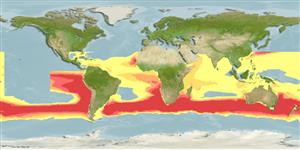Common names from other countries
>
Zeiformes (Dories) >
Oreosomatidae (Oreos) > Oreosomatinae
Etymology: Allocyttus: Greek, allos = other + Greek, kyttaros, kytos = a convex cavity.
Environment: milieu / climate zone / depth range / distribution range
Ecologie
marien bathypelagisch; oceanodroom (Ref. 51243); diepte 0 - 1800 m (Ref. 50610), usually 800 - 1200 m (Ref. 6545). Deep-water; 28°N - 58°S
Eastern Atlantic: off Mauritania, Gulf of Guinea, Namibia and South Africa. Western Atlantic: off Suriname, southern Brazil and Uruguay. Western Indian Ocean: Mozambique Channel, Walters Bank. Eastern Indian Ocean: East Indian and West Australian Ridge, Australia. South Pacific: New Zealand and off Chile. Records from the North Pacific belong to Allocyttus folletti. Also Ref. 26139).
Lengte bij maturiteit / Grootte / Gewicht / Leeftijd
Maturity: Lm 28.0, range 23 - ? cm
Max length : 42.5 cm TL mannelijk / geslacht onbekend; (Ref. 27159); max. gepubliceerd gewicht: 2.0 kg (Ref. 27124); max. gerapporteerde leeftijd: 140 Jaren (Ref. 39383)
Dorsale stekels (totaal) : 5 - 8; Dorsale zachte stralen (totaal) : 28 - 33; Anale stekels: 2 - 3; Anale zachte stralen: 26 - 31. Adults blackish black in color; prejuveniles silvery, back greenish with large grey blotches that disappears at about 12 cm (Ref. 6548).
Occurs on the continental slope (Ref. 9563), forming large shoals over rough ground near pinnacles and canyons (Ref. 6390). Juveniles are pelagic and inhabit oceanic waters in depths of less than 1000 m (Ref. 27230). They tend to be dispersed over smooth grounds (Ref. 6390). Feeds on shrimps, cephalopods, and fishes (Ref. 6548). The eggs float near the sea surface and the larvae also inhabit surface waters (Ref. 6390). Trawl catch rates for warty oreos, and for oreos in general, show no evidence of vertical migration during day or night (Ref. 27150), even though many of the planktonic species consumed by this species undergo daily migrations within the water column (Ref. 6390).
Levenscyclus en paargedrag
Maturities | Voortplanting | Spawnings | Egg(s) | Fecundities | Larven
Displays seasonally synchronised reproduction.
Karrer, C., 1990. Oreosomatidae. p. 637-640. In J.C. Quero, J.C. Hureau, C. Karrer, A. Post and L. Saldanha (eds.) Check-list of the fishes of the eastern tropical Atlantic (CLOFETA). JNICT, Lisbon; SEI, Paris; and UNESCO, Paris. Vol. 2. (Ref. 6545)
Status op de Rode Lijst van het IUCN (Ref. 130435)
CITES (Ref. 128078)
Not Evaluated
Gevaar voor de mens
Harmless
Gebruik door de mens
Visserij: van minder commercieel belang
Tools
Speciale rapporten
Download XML
Internetbronnen
Estimates based on models
Preferred temperature (Ref.
115969): 3.4 - 6.9, mean 4.9 (based on 252 cells).
Fylogenetische diversiteitsindex (Ref.
82804): PD
50 = 0.5635 [Uniqueness, from 0.5 = low to 2.0 = high].
Bayesian length-weight: a=0.01380 (0.00803 - 0.02372), b=3.05 (2.89 - 3.21), in cm Total Length, based on LWR estimates for this species & (Sub)family-body (Ref.
93245).
Trofisch niveau (Ref.
69278): 4.2 ±0.73 se; based on food items.
Weerstandsvermogen (Ref.
120179): Zeer laag, minimale populatieverdubbelingstijd meer dan 14 jaar (tmax=140).
Fishing Vulnerability (Ref.
59153): High to very high vulnerability (68 of 100).
